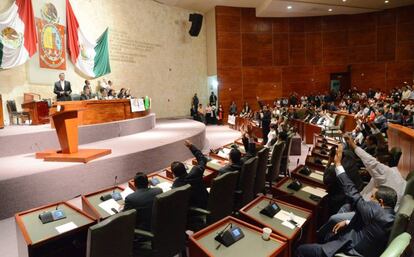Mexican women in politics: no glittering careers and no real power
Despite gender parity laws, female representation remains low in influential public office positions


Tonantzin Cárdenas nearly lost her chance to run in an election because she is a woman. The 24-year-old was unable to register as the replacement for Roberto Castillo, an independent candidate to represent Mexico City in Congress, because voting laws say that both nominees must be of the same gender.
This legislation was developed to prevent men from replacing women in parliament, yet it was now working against Cárdenas. She appealed before the Electoral Tribunal, and this body made an exception: Cárdenas will run in the July 1 election after all.
If we don’t do something about it, we will continue to be relegated to inferior positions
Gabriela González Pita
But this kind of restriction, and others like it, are preventing female politicians from coming anywhere near a participation rate of 50% inside Mexico’s bicameral Congress of the Union. The lower house, the Chamber of Deputies, has 500 lawmakers, of which 159 (31.8%) are women. The 128-seat Senate has 51 female senators, or 39.8%.
Even though women have better representation in the Senate, their role in legislative matters tends to be smaller: out of 64 committees in charge of reviewing national affairs, only 19 were headed by a woman.
Electoral law has been changed in recent years to get political parties to include more women on their lists, but this has not guaranteed their participation in politics once they attain public office.
“There may be gender parity when it comes to positions, but women do not necessarily have 50% of power within parties; in the best of cases they don’t even have the same level of influence that men have,” notes Ximena Andión, director of the Simone de Beauvoir Leadership Institute.

Gabriela González Pita, a teacher, was looking to run in Acayucan, a town in the state of Veracruz, but her party alleged that it had no money to back her, even though male contenders did find the support they needed. That was one of the ways in which she was discriminated against, although there are others.
Mexican women are also barred from politics through pressure that can include political violence (causing damage to their public image), double workloads that prevent them from achieving a work-life balance, and even sexual harassment.
This low female representation is also evident in President Enrique Peña Nieto’s own Cabinet: there are only five female ministers out of a group of 30. And their portfolios are related to culture, social development, public agency oversight, women’s issues and social assistance.
There may be gender parity when it comes to positions, but women do not necessarily have 50% of power within parties
Ximena Andión, Simone de Beauvoir Institute
According to the Simone de Beauvoir Institute, out of all the municipalities in Mexico, only 12% have female mayors. And only 20% of judges serving in the judiciary are women. The Supreme Court of Justice of the Nation (SCJN) is made up of nine men and two women. Out of the 32 Mexican states, only one, Sonora, has a female governor, Claudia Pavlovich.
The OECD notes that in Mexico, 48.73% of government employees are female, but that figure drops to 36.81% in the federal government. The higher they aim, the more women’s presence progressively diminishes.
For this year’s presidential elections, the National Electoral Institute (INE) has over 44 million registered female voters, representing 52% of the eligible voter base. But female representation in politics is still a pending subject.
“If we don’t do something about it, we will continue to be relegated to losing municipalities and inferior positions, to make sure we don’t get there,” said González Pita.
English version by Susana Urra.
Tu suscripción se está usando en otro dispositivo
¿Quieres añadir otro usuario a tu suscripción?
Si continúas leyendo en este dispositivo, no se podrá leer en el otro.
FlechaTu suscripción se está usando en otro dispositivo y solo puedes acceder a EL PAÍS desde un dispositivo a la vez.
Si quieres compartir tu cuenta, cambia tu suscripción a la modalidad Premium, así podrás añadir otro usuario. Cada uno accederá con su propia cuenta de email, lo que os permitirá personalizar vuestra experiencia en EL PAÍS.
¿Tienes una suscripción de empresa? Accede aquí para contratar más cuentas.
En el caso de no saber quién está usando tu cuenta, te recomendamos cambiar tu contraseña aquí.
Si decides continuar compartiendo tu cuenta, este mensaje se mostrará en tu dispositivo y en el de la otra persona que está usando tu cuenta de forma indefinida, afectando a tu experiencia de lectura. Puedes consultar aquí los términos y condiciones de la suscripción digital.
More information
Archived In
Últimas noticias
The complicated life of Francesca Albanese: A rising figure in Italy but barred from every bank by Trump’s sanctions
How Japan is trying to avert ‘digital defeat’
Half of Scotland is in the hands of 420 property owners
From digital curfews to blocking apps: How technology experts protect their children online
Most viewed
- Why we lost the habit of sleeping in two segments and how that changed our sense of time
- Trump’s obsession with putting his name on everything is unprecedented in the United States
- Charles Dubouloz, mountaineering star, retires at 36 with a farewell tour inspired by Walter Bonatti
- The Florida Keys tourist paradise is besieged by immigration agents: ‘We’ve never seen anything like this’
- Living in a motorhome due to soaring housing prices in Madrid: ‘I got used to it quickly, but I don’t idealize it’










































